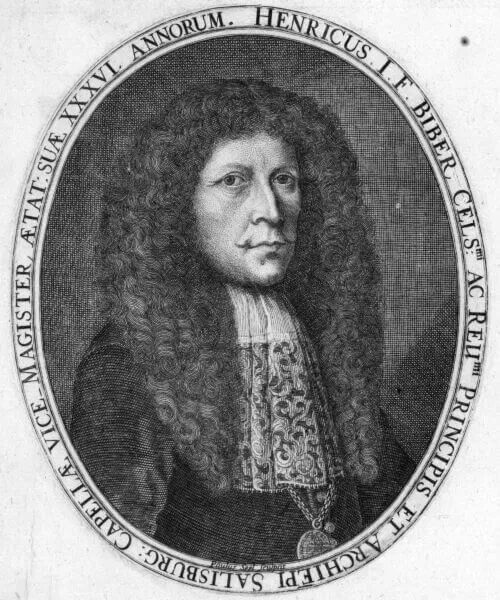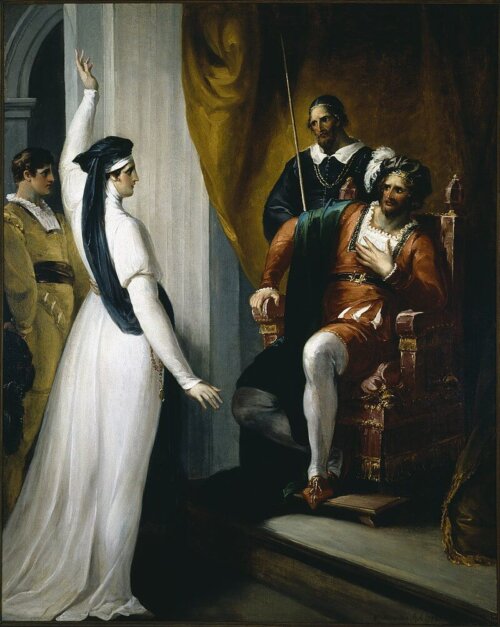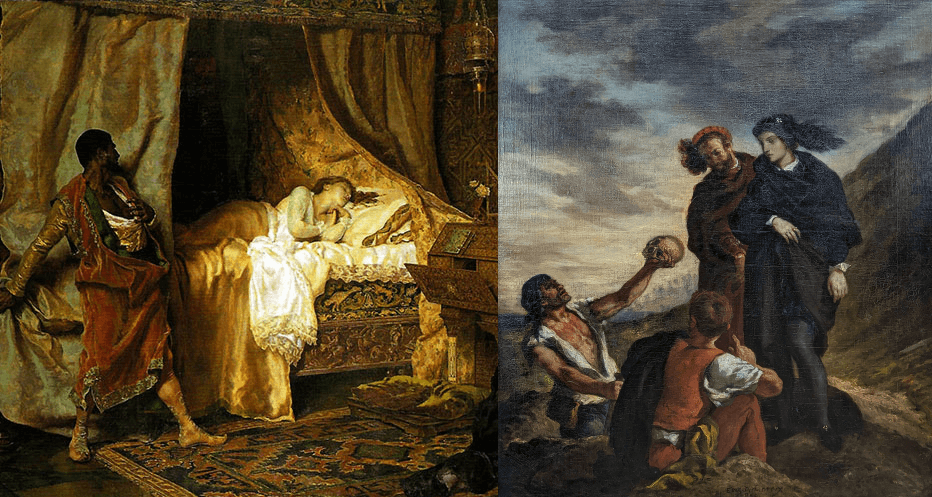The Glorious Music of Heinrich Biber

Fifty years ago, most music lovers had not heard of Heinrich Ignaz Franz Biber (1644-1704), let alone heard any of his works. Now he has claimed his place in the canon of great composers. Upon viewing the complete edition of his music, Paul Hindemith went so far as to call Biber the greatest composer before Johann Sebastian Bach. This remarkable rise in stature is thanks to the early music revival of recent decades, which has changed our perspective on the history of music.
At one time Baroque music had the reputation of being formally structured, almost mathematical. Biber’s works—wild, improvisatory, fantastical—seemed to put the lie to this stereotype. A virtuoso of the violin, Biber raised the instrument to astounding new heights of technique and expression. Yet though violin music was his specialty, Biber also composed splendid sacred pieces for the Salzburg Cathedral, exploiting the church’s magnificent architecture. One of these, the gigantic Missa Salisburgensis (Salzburg Mass), featured seven ensembles positioned throughout the cathedral for a stereophonic effect.
All Biber’s music evokes its time and place—Catholic South Germany in the late 1600s—with a swirling exuberance that leaves room for profound meditation. Biber was born in German-speaking Bohemia (then part of the Austrian Hapsburg Empire), educated by Jesuits, and spent most of his working life in Salzburg. His education is reflected in his given names (Ignatius and Francis) and in a humanistic outlook that delighted in florid Latin titles and dedications. In one of these he speaks of his “faith in fiddles,” playing on the Latin word fides, meaning either “faith” or “stringed instrument.” A robust good humor pervades much of his music, too.
What makes Biber my favorite composer is the way his music reconciles the spiritual and the earthly, and earthy, aspects of existence. In Biber’s world the sacred and the secular were integrated in a way we can only imagine today. According to musicologist Charles E. Brewer, music “was thought to have the power to make the most sacred rituals pleasing and to allow even the most secular entertainments to be imbued with piety.” Music was a human reflection of divine order and as such pervaded all of reality, “whether it was at a table filled with culinary delights or a table upon which the mystery of the Eucharist was performed.”
Many of Biber’s works point to this union of sacred and secular, even in their titles: Fidicinium Sacro-Profanum (roughly, “Sacred/Profane String Music”), Sonatae tam aris quam aulis servientes (“Sonatas Suitable for the Court as for the Altar”), and a delightful suite called The Peasants’ Procession to Church, in which morning dawns, peasants gradually assemble in church singing a chorale to the Blessed Virgin and then celebrate afterwords in a tavern. This is not to mention such outrageously secular pieces as Battalia (a depiction of a battle) and Sonata representativa, in which the violin imitates a menagerie of birds and animals.
Music in Biber’s day adorned birthdays, name days, weddings, banquets, and religious functions of all kinds. Because of this close integration of music and life, musicians were typically regarded as skilled artisans, or even as servants in the courtly retinue. Biber managed to break out of this mold in 1690 when he was knighted by the Holy Roman Emperor; his only known portrait shows him wearing a medal gifted him by that ruler. Biber’s regular patron, however, was the archbishop of Salzburg, to whom he dedicated his most famous work.
This was the Sonatas on the Mysteries of the Rosary for violin and figured bass (typically played on organ, harpsichord or other chordal instruments). It is Biber’s masterpiece and the work which put his name “on the map” in recent times. A fair amount of mystery surrounds the cycle of pieces. We don’t even know what Biber intended to call it, since his title page has been lost. We don’t know where or under what circumstances it was originally performed, either; it may well have accompanied an actual recitation of the rosary, with the sonatas performed in between the decades to enhance meditation.
There are fifteen sonatas corresponding to the fifteen Joyous, Sorrowful, and Glorious Mysteries; in the original manuscript, each sonata was accompanied by a copper-plate engraving. Biber uses a wealth of musical symbolism to suggest the sacred scenes. Chief among these is scordatura—a procedure that involves retuning the strings of the violin to achieve different tone colors and execute passages that would be difficult or impossible in the normal tuning. Each of the sonatas has a different scordatura tuning, and each creates a sound world appropriate to the mystery.
In the Joyous Mysteries the tunings are bright, emphasizing the resonance of the violin’s open (unstopped) strings. In the Sorrowful Mysteries the tunings and tonalities take on an increasingly dark and foreboding hue, the violin’s resonance choked by the dissonant tunings.
The Glorious Mysteries bring with them a sense of exaltation as the scordatura again turns bright and luminous. The Resurrection calls for the violinist to symbolically reconfigure his violin, crossing the two middle strings and creating a visual cross on the instrument. In the Descent of the Holy Spirit we get musical flames; in the Assumption, Mary seems to dance up to Heaven to the strains of a jig. The cycle concludes with a Passacaglia—a series of variations on a repeating bass pattern—for violin alone; the accompanying engraving depicts a guardian angel.
Performing the entire Mystery Sonatas is a feat of endurance and skill, not to mention emotional empathy with the story of Jesus and Mary. This is a key element in Biber’s aesthetic: the sense of human accomplishment, the delight in sheer instrumental wizardry. Through the scordatura, Biber makes the violin transcend the natural and approach the supernatural, or at least break through the bounds of the possible.
It was during the Baroque era that instrumental music acquired an independent life of its own, and the violin, with its “singing” quality, its emotional and physical vulnerability, was regarded as the most human of instruments. It became a chief vehicle for the Baroque exaltation of individual expression, and the violinist became a sort of tone-poet who could move audiences to rapture. One can only imagine what Biber must have been like as a performer, but to judge from his music he must have been electrifying. A contemporary description of another great violinist, Arcangelo Corelli, might give us some clue: “It was usual for his countenance to be distorting, his eyes to become red as fire, and his eyeballs to roll as if in agony, and he gives in so much to what he is doing that he doth not look like the same man.”
The violin of Biber’s day was fitted with sheep-gut strings and played with a light, flexible bow curved like the bow of an archer. The sound it produced was clear, open and resonant, with something of the twang of a country fiddle. As a player of the Baroque violin, I can testify to the difference it makes in putting across earlier music. This instrument, its strings and bow were simply made for the florid and stunning passage work that Biber wrote and the harmonic resonances he called for.
In exploring Biber’s violin music on record, you can’t go wrong with John Holloway, perhaps the foremost Biber specialist today. No one brings quite the combination of technique and spiritual intensity that Holloway does, as revealed on his numerous Biber recordings, including the Mystery Sonatas. Holloway has stated (and I concur with his sentiment): “After many years of performing these works, I feel that I’m getting to know and admire all the more this complex and fascinating man.”
Musical fashions come and go, and by the early 1700s Biber’s extravagant violin music was giving way to the simpler and sweeter style of Corelli. It was left to the twentieth century to restore his work to its rightful place, with the manuscript of the Mystery Sonatas rediscovered and published in 1905. As for myself, I have no qualms about adding him to the “three B’s”—Bach, Beethoven, and Brahms. Biber has emerged as one of the most fascinating figures of Western music, and his “faith in fiddles” continues to gain converts.
This was originally published with the same title in The Imaginative Conservative on March 16, 2019.




